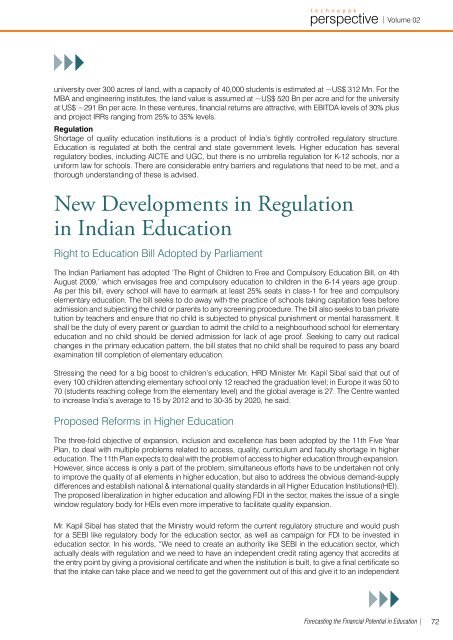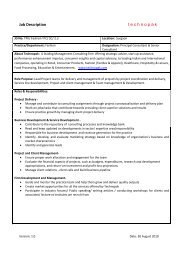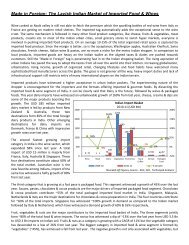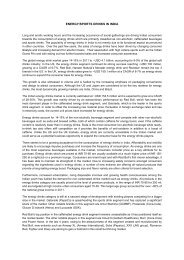a quarterly report by - Technopak
a quarterly report by - Technopak
a quarterly report by - Technopak
Create successful ePaper yourself
Turn your PDF publications into a flip-book with our unique Google optimized e-Paper software.
perspective<br />
a quar terly repor t <strong>by</strong><br />
Volume 02 / 2009<br />
| Volume 02<br />
university over 300 acres of land, with a capacity of 40,000 students is estimated at ~US$ 312 Mn. For the<br />
MBA and engineering institutes, the land value is assumed at ~US$ 520 Bn per acre and for the university<br />
at US$ ~291 Bn per acre. In these ventures, financial returns are attractive, with EBITDA levels of 30% plus<br />
and project IRRs ranging from 25% to 35% levels.<br />
Regulation<br />
Shortage of quality education institutions is a product of India’s tightly controlled regulatory structure.<br />
Education is regulated at both the central and state government levels. Higher education has several<br />
regulatory bodies, including AICTE and UGC, but there is no umbrella regulation for K-12 schools, nor a<br />
uniform law for schools. There are considerable entry barriers and regulations that need to be met, and a<br />
thorough understanding of these is advised.<br />
New Developments in Regulation<br />
in Indian Education<br />
Right to Education Bill Adopted <strong>by</strong> Parliament<br />
The Indian Parliament has adopted ‘The Right of Children to Free and Compulsory Education Bill, on 4th<br />
August 2009,’ which envisages free and compulsory education to children in the 6-14 years age group.<br />
As per this bill, every school will have to earmark at least 25% seats in class-1 for free and compulsory<br />
elementary education. The bill seeks to do away with the practice of schools taking capitation fees before<br />
admission and subjecting the child or parents to any screening procedure. The bill also seeks to ban private<br />
tuition <strong>by</strong> teachers and ensure that no child is subjected to physical punishment or mental harassment. It<br />
shall be the duty of every parent or guardian to admit the child to a neighbourhood school for elementary<br />
education and no child should be denied admission for lack of age proof. Seeking to carry out radical<br />
changes in the primary education pattern, the bill states that no child shall be required to pass any board<br />
examination till completion of elementary education.<br />
Stressing the need for a big boost to children’s education, HRD Minister Mr. Kapil Sibal said that out of<br />
every 100 children attending elementary school only 12 reached the graduation level; in Europe it was 50 to<br />
70 (students reaching college from the elementary level) and the global average is 27. The Centre wanted<br />
to increase India’s average to 15 <strong>by</strong> 2012 and to 30-35 <strong>by</strong> 2020, he said.<br />
Proposed Reforms in Higher Education<br />
The three-fold objective of expansion, inclusion and excellence has been adopted <strong>by</strong> the 11th Five Year<br />
Plan, to deal with multiple problems related to access, quality, curriculum and faculty shortage in higher<br />
education. The 11th Plan expects to deal with the problem of access to higher education through expansion.<br />
However, since access is only a part of the problem, simultaneous efforts have to be undertaken not only<br />
to improve the quality of all elements in higher education, but also to address the obvious demand-supply<br />
differences and establish national & international quality standards in all Higher Education Institutions(HEI).<br />
The proposed liberalization in higher education and allowing FDI in the sector, makes the issue of a single<br />
window regulatory body for HEIs even more imperative to facilitate quality expansion.<br />
Mr. Kapil Sibal has stated that the Ministry would reform the current regulatory structure and would push<br />
for a SEBI like regulatory body for the education sector, as well as campaign for FDI to be invested in<br />
education sector. In his words, “We need to create an authority like SEBI in the education sector, which<br />
actually deals with regulation and we need to have an independent credit rating agency that accredits at<br />
the entry point <strong>by</strong> giving a provisional certificate and when the institution is built, to give a final certificate so<br />
that the intake can take place and we need to get the government out of this and give it to an independent<br />
Forecasting the Financial Potential in Education | 72















